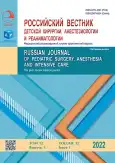Использование дексмедетомидина в анестезиологическом обеспечении многократно оперированного пациента с внепеченочной формой портальной гипертензии: клиническое наблюдение
- Авторы: Налеев А.А.1, Лазарев В.В.1,2, Линькова Т.В.1, Цыпин Л.Е.1,2
-
Учреждения:
- Российская детская клиническая больница им. Н.И. Пирогова
- Российский национальный исследовательский медицинский университет им. Н.И. Пирогова
- Выпуск: Том 12, № 1 (2022)
- Страницы: 93-98
- Раздел: Клинические случаи
- URL: https://journals.rcsi.science/2219-4061/article/view/123594
- DOI: https://doi.org/10.17816/psaic1036
- ID: 123594
Цитировать
Полный текст
Аннотация
Введение. Применение высоких доз опиоидов и общих анестетиков может приводить к нежелательным побочным эффектам, что непосредственно сказывается на восстановлении пациента, его психоэмоциональном и социальном благополучии. В связи с этим выбор методик общего обезболивания, позволяющих сократить дозы применения общих анестетиков и опиоидных анальгетиков, является актуальным, особенно у детей с сопутствующей тромбоцитопенией, не позволяющей воспользоваться эпидуральной блокадой.
Описание наблюдения. В статье представлено описание применения альфа-2-адреноагониста дексмедетомидина в анестезиологическом обеспечении у девочки 16 лет при выполнении корригирующей операции по поводу внепеченочной портальной гипертензии после нескольких ранее выполненных операций. Использование в схеме общей анестезии селективного альфа-2-агониста адренорецепторов дексмедетомидина позволило обеспечить эффективное и стабильное обезболивание интраоперационно, а также быстрое восстановление самостоятельного дыхания и сознания после анестезии. Общая доза интраоперационного расхода фентанила в сравнении с ранее выполненной анестезией была меньше в 2 раза, а севофлурана на 30 % при сохранении адекватной анестезиологической защиты.
Заключение. При невозможности выполнения эпидуральной анестезии у пациентов с тромбоцитопенией при внепеченочной портальной гипертензии во время оперативных вмешательств в плане снижения доз используемых анестетиков и опиоидных анальгетиков может быть применение альфа-2-адреномиметика центрального действия — дексмедетомидина.
Ключевые слова
Полный текст
Открыть статью на сайте журналаОб авторах
Алексей Александрович Налеев
Российская детская клиническая больница им. Н.И. Пирогова
Email: dr.naleyev@gmail.com
ORCID iD: 0000-0002-9383-5167
SPIN-код: 3768-9995
врач – анестезиолог-реаниматолог
Россия, 119571, Москва, Ленинский пр., д. 117Владимир Викторович Лазарев
Российская детская клиническая больница им. Н.И. Пирогова; Российский национальный исследовательский медицинский университет им. Н.И. Пирогова
Email: lazarev_vv@inbox.ru
ORCID iD: 0000-0001-8417-3555
SPIN-код: 4414-0677
д-р мед. наук, профессор, заведующий кафедрой детской анестезиологии и интенсивной терапии ФДПО, врач – анестезиолог-реаниматолог
Россия, 119571, Москва, Ленинский пр., д. 117; МоскваТатьяна Викторовна Линькова
Российская детская клиническая больница им. Н.И. Пирогова
Email: linkovat@gmail.com
ORCID iD: 0000-0002-3275-9332
SPIN-код: 5720-4209
канд. мед. наук, врач – анестезиолог-реаниматолог
Россия, 119571, Москва, Ленинский пр., д. 117Леонид Ефимович Цыпин
Российская детская клиническая больница им. Н.И. Пирогова; Российский национальный исследовательский медицинский университет им. Н.И. Пирогова
Автор, ответственный за переписку.
Email: 1dca@mail.ru
ORCID iD: 0000-0002-3114-8759
SPIN-код: 5062-2010
д-р мед. наук, профессор, врач – анестезиолог-реаниматолог
Россия, 119571, Москва, Ленинский пр., д. 117; МоскваСписок литературы
- Khanna R, Sarin SK. Non-cirrhotic portal hypertension diagnosis and management. J Hepatol. 2014;60(2):421–441. doi: 10.1016/j.jhep.2013.08.013
- Wani ZA, Bhat RA, Bhadoria AS, Maiwall R. Extrahepatic portal vein obstruction and portal vein thrombosis in special situations: Need for a new classification. Saudi J Gastroenterol. 2015;21(3):129–138. doi: 10.4103/1319-3767.157550
- Gugig R, Rosenthal P. Management of portal hypertension in children. World J Gastroenterol. 2012;18(11):1176–1184. doi: 10.3748/wjg.v18.i11.1176
- Vogel CB. Pediatric portal hypertension: A review for primary care. Nurse pract. 2017;42(5):35–42. doi: 10.1097/01.NPR.0000515427.91649.91
- Belskiy VA, Molkov AM, Utkin IA, et al. Anaesthesia protocol to extended liver resections: a paradigm shift under the influence of the experience of liver transplantation (literature review). Annals of HPB Surgery. 2016;21(2):39–51. (In Russ.) doi: 10.16931/995-5464.2016239-51
- Kehlet H, Holte K. Effect of postoperative analgesia on surgical outcome. Br J Anaesth. 2001;87(1):62–72. doi: 10.1093/bja/87.1.62
- Van Dam RM, Hendry PO, Coolsen MM. Initial experience with a multimodalenhanced recovery programme in patients undergoing liver resection. Br J Surg. 2008;95(8):969–975. doi: 10.1002/bjs.6227
- Jacquenod P, Wallon G, Gazon M, et al. Incidence and risk factors of coagulation profile derangement after liver surgery: implications for use of epidural analgesia. Retrospective cohort study. Anaesthesia and Analgesia. 2018;126(4):1142–1147. doi: 10.1213/ANE.0000000000002457
- Peck-Radosaveljevic M. Hypersplenism. Eur J Gastroenterol Hepatol. 2001;13(4):317–323. doi: 10.1097/00042737-200104000-00004
- Khusainova II. Comparative evaluation of methods of anesthesia during operations in gynecologic oncology. Medicine. 2016;(2):16–22. (In Russ.)
- Khomyakov EA, Rybakov EG, Zarodnyuk IV, et al. Risk factors of postoperative prolonged ileus after colorectal cancer surgery. Grekov’s Bulletin of Surgery. 2017;176(5):82–87. (In Russ.) doi: 10.24884/0042-4625-2017-176-5-82-87
- Colvin LA, Bull F, Hales TG. Perioperative opioid analgesia-when is enough too much? A review of opioid-induced tolerance and hyperalgesia. Lancet. 2019;393(10180):1558–1568. doi: 10.1016/S0140-6736(19)30430-1
- Kim HJ, Kim MS, Kim HY, et al. Effect of Timing of Intravenous Fentanyl Administration on the Incidence of Posttonsillectomy Nausea and Vomiting. Laryngoscope. 2020;130(12):2900–2905. doi: 10.1002/lary.28533
- Ayad S, Khanna AK, Iqbal SU, Singla N. Characterisation and monitoring of postoperative respiratory depression: current approaches and future considerations. Br J Anaesth. 2019;123(3):378–391. doi: 10.1016/j.bja.2019.05.044
- Ovezov AM, Panteleeva MV, Knyazev AV, et al. Neurotoxicity of general anesthetics: A modern view of the problem. Neurology, Neuropsychiatry, Psychosomatics. 2015;7(4):78–82. (In Russ.) doi: 10.14412/2074-2711-2015-4-78-82
- Wrigge H, Uhlig U, Zinserling J, et al. The effect of different ventilator settings on pulmonary and systemic inflammatory responses during major surgery. Anaesthesia and Analgesia. 2004;98(3):775–781. doi: 10.1213/01.ane.0000100663.11852.bf
- Ivchenko AP, Kitiashvili DI. Modern aspects of premedication within the concept of fast track surgery. Journal of new medical technologies. 2016;23(1):91–95 (In Russ.) doi: 10.12737/18490
Дополнительные файлы







